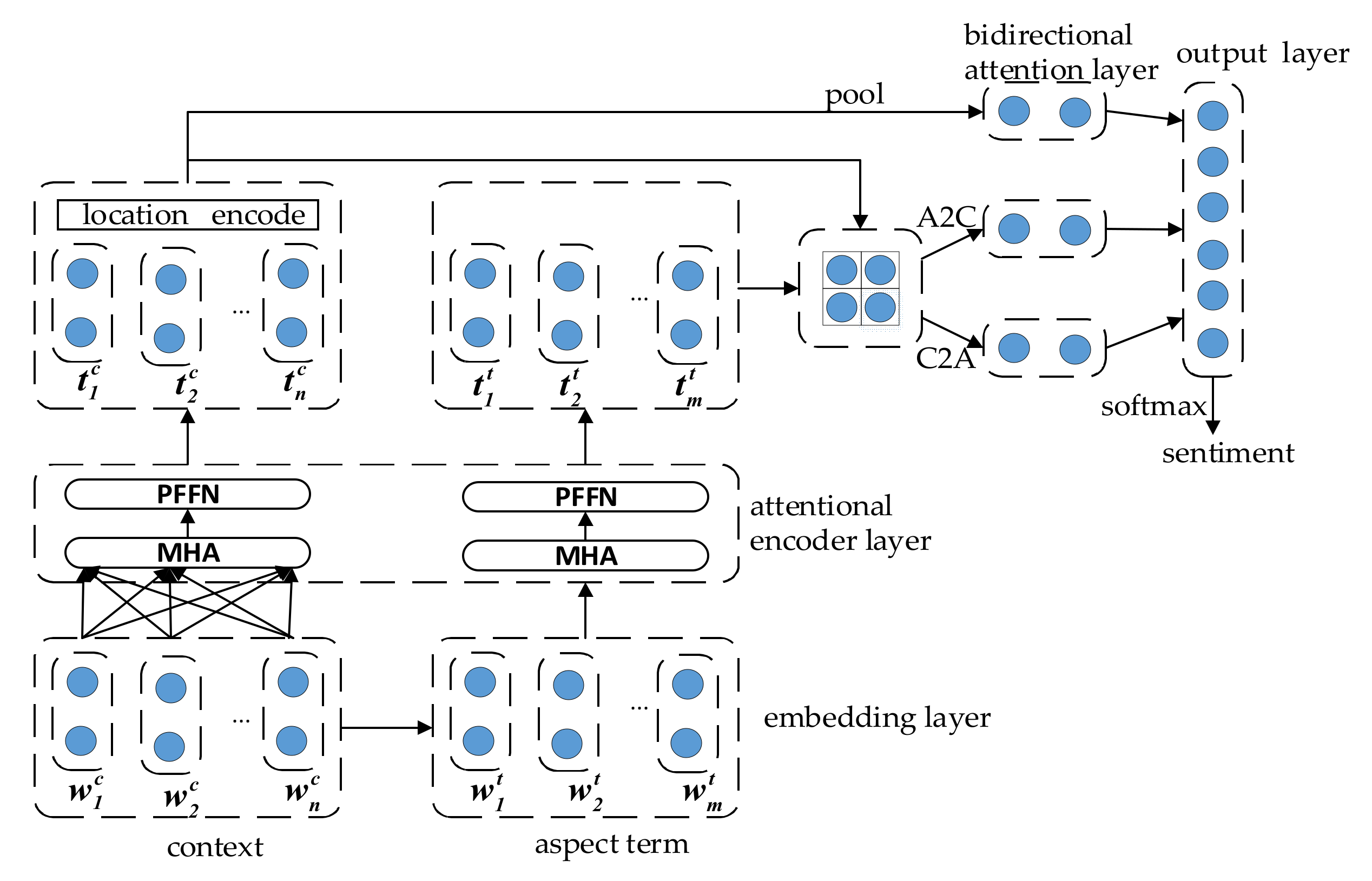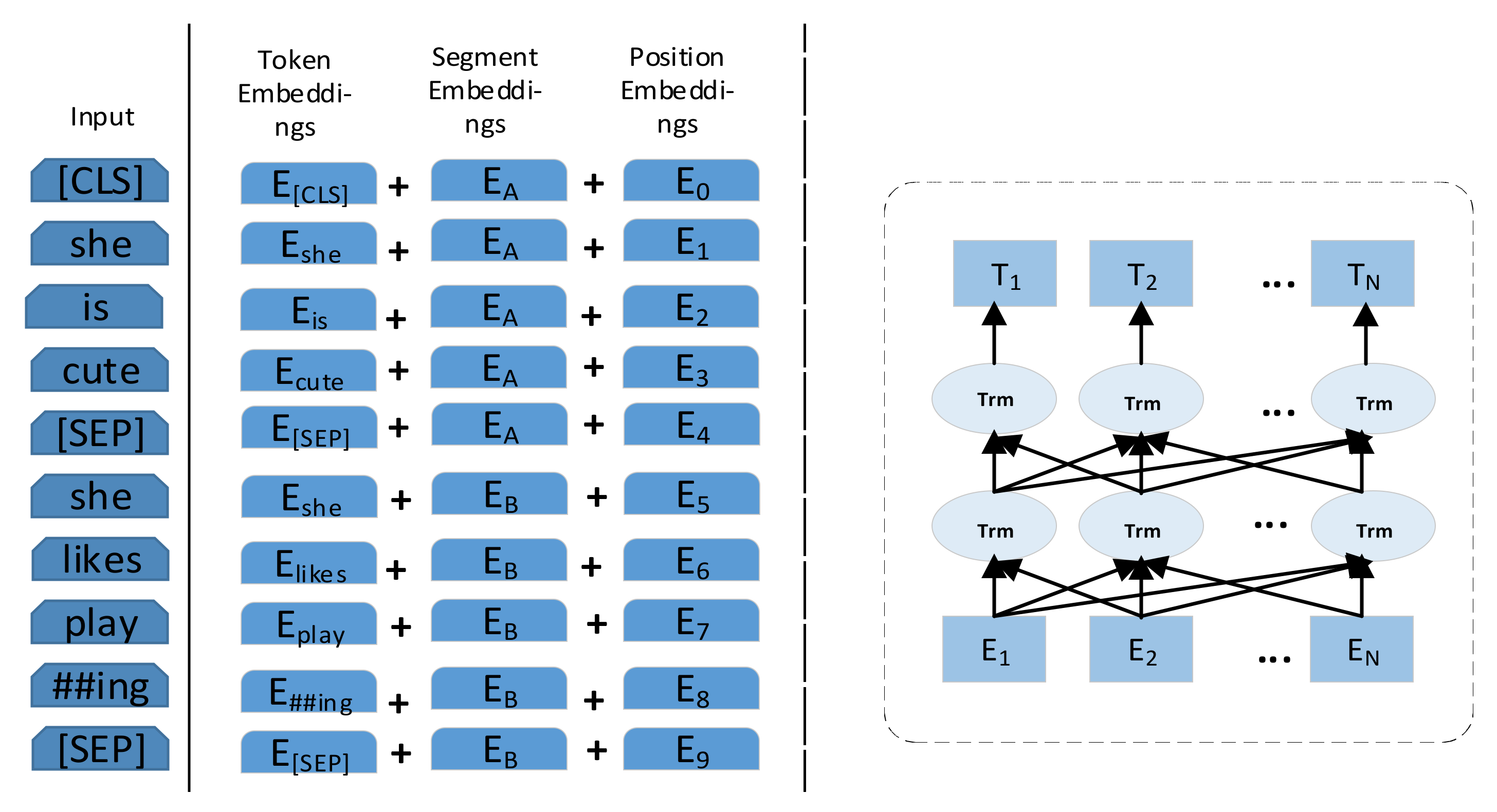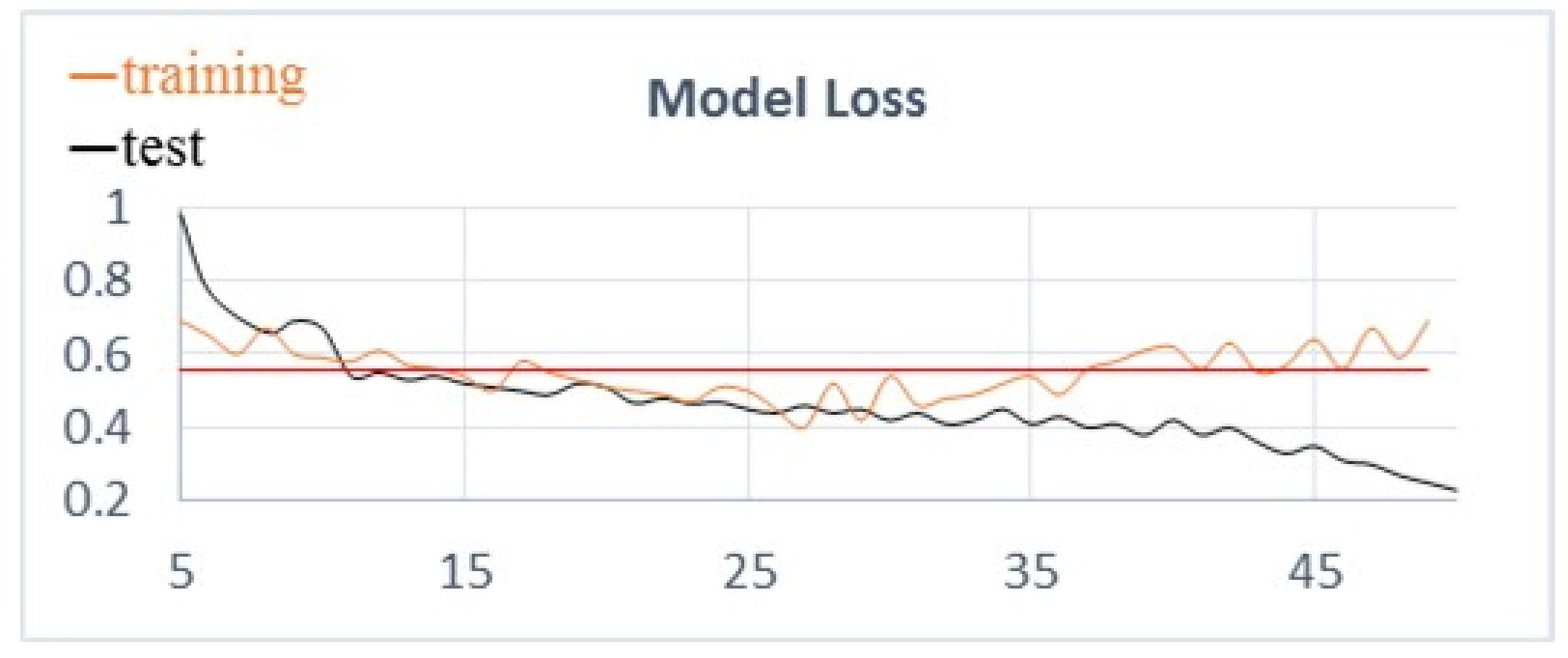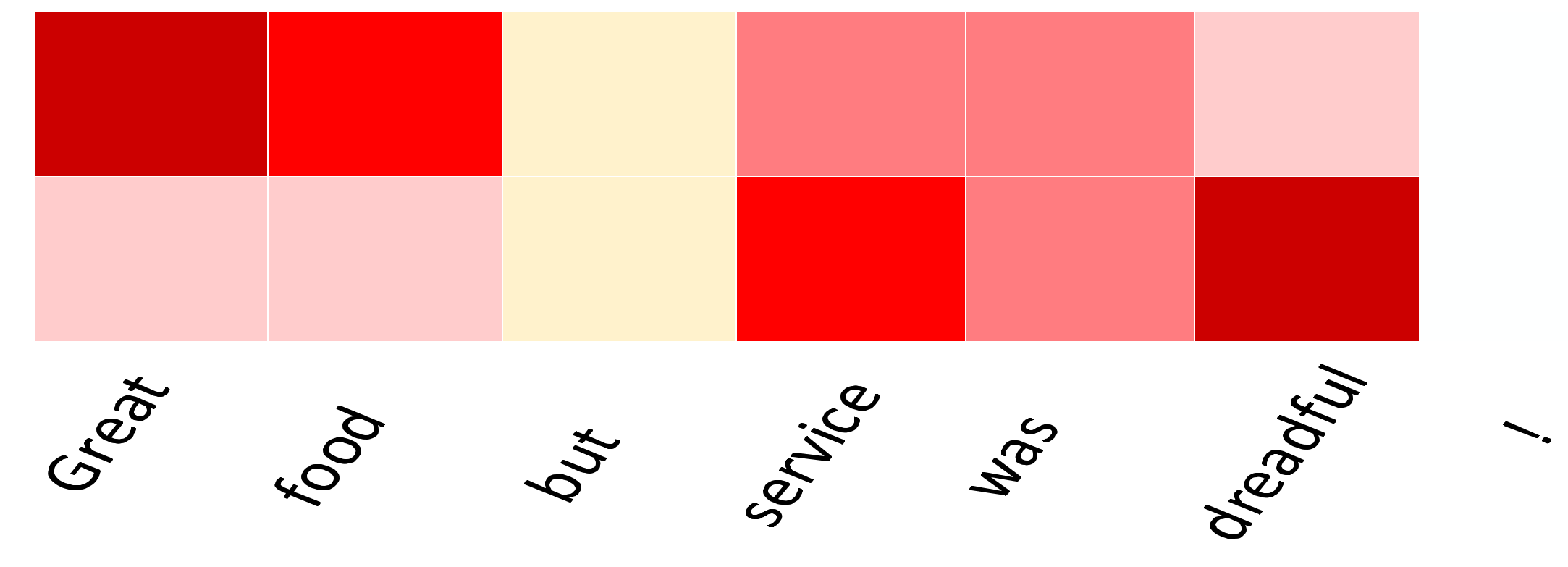1. Introduction
Text sentiment analysis, is the process of analyzing, processing, summarizing, and inferring subjective text with sentiment polarity, which is a vital task in natural language processing (NLP) and is also known as opinion mining [
1]. With the rapid development of Internet technology and continuous popularity of social networks, people express their opinions on different platforms, such as online social media, product review websites and other media. Thus, accumulating a large amount of text information data. Relevant comments and opinions have become an important reference for users, and even in academic research, they are also interested in the processing of massive data. In recent years, aspect-level sentiment analysis (ASA) is proposed, which could understand reviews better than traditional sentiment analysis and aim at identifying the sentiment polarity of an input sentence in a certain aspect term [
2]. For example, given the sentence “Great food but service was dreadful”, the polarity of the sentence towards the aspect “food” is positive while the polarity of “service” is negative.
Previously, most of the literatures make use of neural networks to capture the sequence information and automatically learn useful representations of context and aspect terms [
3], such as Recurrent Neural Network (RNN), Convolutional Neural Networks (CNN), and Long Short-Term Memory (LSTM). Xue et al. [
4] proposed a method of target extraction based on the gated convolution network, which was easy to confuse the sentiment polarity of aspect terms and could not achieve better fusion with the original sentence. The transduction learning approach proposed by Marcacini et al. [
5] is able to extract aspect terms well, but it did not fully analyze the sentiment of a particular aspect term. However, the existing neural network models are not effective enough in dealing with ASA tasks alone, and they are still in the immature stage of processing fine-grained sentiment analysis tasks.
It can be seen that most of the current models of ASA tasks adopt the method of combining neural networks and attention mechanisms. Attention is widely used in machine translation [
6] and reading comprehension [
7]. Therefore, a number of researchers have also used attention mechanisms to solve ASA tasks, which could focus on the effect of different contextual words on the target [
8]. Tang et al. [
9] proposed the Memory Network (MemNet) model, which consists of computational layers of shared parameters. Each layer contains an attention layer and a linear layer. Wang et al. [
10] proposed Attention-based LSTM with Aspect Embedding (ATAE-LSTM), which was able to attend to different parts of a sentence when different aspects are concerned. From the experimental results of MemNet and ATAE-LSTM, they all show that the attention mechanism is effective. Considering that neural networks are difficult to parallellize and requires a great deal of computation, this paper chooses to use multiple attention mechanisms to complete the task.
Currently, word embedding and aspect term embedding usually use the original data preprocessing methods, such as Glove [
11] and Word2vec. For example, Ma et al. [
12] proposed that context embedding and aspect term embedding be used for inputting for ASA, and Glove be used for preprocessing input data. For the ASA task and datasets proposed in this paper, we find the data preprocessed by Bidirectional Encoder Representations from Transformers (BERT) [
13] will greatly improve the effect of downstream tasks. Therefore, BERT is adopted to preprocess data onto this paper. Through the experimental comparison of this paper, the method improves the experimental results effectively.
Inspired by the above problems, we propose a Multi-Attention Network (MAN) model for ASA. This paper mainly completes the ASA task, which is a fine-grained sentiment analysis task, and the goal is to infer the corresponding sentiment polarity for given sentences with aspect terms, such as positive, negative, and neutral.
The main contributions of our work are as follows:
The method proposed in this paper mainly adopts an attention network. We make use of Multihead Attention (MHA) and Point-wise Feed-Forward Networks (PFFN) to interactively obtain the hidden representation of the context and aspect term embeddings, which are akin to a partial transformer [
14]. In addition, for a normal sentence that the distance between context words and aspect terms will have different effects, so this paper includes location encoding into this model.
Considering that words in different positions have different influences on aspect terms, the bidirectional attention network is adopted to analyze the influences and correlations of different words on them.
Experiments were carried out on three different public authoritative datasets, including multiple baseline models and ablation studies. The experimental results show that the approach proposed in this paper outperforms state-of-the-art methods.
The rest of this paper is organized as follows:
Section 2 presents the main methods about ASA, as well as the related work.
Section 3 describes in detail our MAN model, especially the description of MHA and PFFN for sequence information extraction. The experimental evaluation results comparing our MAN model and other state-of-the-art methods for ASA are presented and discussed in
Section 4, with additional ablation experiments. Finally,
Section 5 discusses the conclusion of this work and the direction of future work.
3. Multi-Attention Network
In this section, we will introduce a new model proposed in this paper for solving ASA tasks, called Multi-Attention Network (MAN) model, which not only uses new technologies but is more effective than traditional methods. To be specific, the model is shown in
Figure 1, which consists of four components: (1) Datasets are preprocessed using BERT as word embedding and aspect term embedding. (2) Computing the hidden states of the input embeddings by MHA and PFFN. (3) Taking advantage of bidirectional attention network to analyze the interaction between context and aspect terms. (4) The output of the sub-structure is average pooled separately and concatenate as input to softmax function. These four components correspond to embedding layer, attentional encoder layer, bidirectional attention layer, and output layer, respectively.
Given the context sequence and the aspect term sequence , where is a sub-sequence of . The purpose of our proposed model is to predict the sentiment polarity of the sentence over the aspect term .
3.1. Embedding Layer
The input of our model presented in this paper is mainly composed of two parts: word embedding and aspect term embedding. All data are pre-trained using BERT to generate sequence of word vectors. For now, BERT is widely used in a wide range of tasks, which could be a good feature representation for word learning by running self-supervised learning method on the basis of massive corpus. In this paper, BERT is adopted to preprocess all data and the process is shown in
Figure 2.
By Equation (1), word embedding and aspect term embedding are calculated, respectively, where
x generally refers to the input data, which is processed by BERT to generate embeddings
H:
Pre-trained by BERT, word embedding is interactively input into the corresponding MHA and combined with the aspect term embedding to input into another MHA. They all effectively extract the semantic feature of the text and enhance the performance of downstream tasks.
3.2. Attentional Encoder Layer
Attentional encoder layer can parallelize and compute the hidden state of the input embeddings, and its function is similar to LSTM. This layer consists two submodules: the MHA and the PFFN. Next, this paper will cover these two parts in detail.
3.2.1. Multi-Head Attention
MHA is the attention that performs multiple attention functions simultaneously. For context embedding, input its interaction into MHA to achieve the information interaction between contexts. Meanwhile, the context embedding processed by BERT is transmitted to the aspect term embedding, and the two are input into MHA together.
An attention function can be described as mapping a query sequence
and a set of key-value pairs to an output, where the query, keys, values, and output are all vectors. Currently, in NLP research, key and value are often the same, that is, key = value. The key sequence is
. To be honest, both
q and
k are embedding results obtained by different linear transformations. The output is computed as a weighted sum of the values, where the weight assigned to each value is computed by a function of the query with the corresponding key:
The
plays a regulatory role, so that the above inner product is not too large to affect the softmax function [
14], where
f denotes the similarity function between
and
is calculated by concatenating, that is, the semantic relevance between the two:
where
denotes learnable weights.
The MHA allows the model to learn relevant information in different representation subspaces. The different representations obtained are concatenated together and the values obtained by another linear transformation are taken as the results of MHA:
where
and
.
Multihead self-attention is a typical
q =
k mechanism under special situation. The context embedding
are input into MHA, the context representations can be obtained by Equation (6). The complete context is expressed as
.
In normal attention mechanism,
q is different from
k. When the context embedding
and the aspect term embedding
are input into MHA at the same time, we can get the context and target representation:
After MHA calculation, each aspect term embedding is corresponding to context embedding. Then get the context and aspect term are expressed as .
3.2.2. Point-Wise Feed-Forward Networks
A PFFN can transform contextual information gathered by the MHA, which consists of two linear transformations with a ReLU activation in between:
where
h denotes input sequence. The process of PFFN is similar to the convolution operation, that two convolutions of kernel size are 1 and apply the same transformation to every token belonging to the input. From Equation (8),
and
are the learnable weights,
and
are biases. Given
c and
t, PFFN are applied to get the output hidden states of the attentional encoder layer
and
by:
Processed by attentional encoder layer, we can obtain the context and aspect term hidden representations, which is useful for further analysis. In addition, considering that the context words close to the aspect term have a great influence on the aspect, we adopt the location encoding. For example, in the sentence “Great food but service was dreadful!” the word “dreadful” should describe the aspect term “service” not “food”. The weight for a context word
, which the distance from the aspect term is
l [
21]. It is defined as:
When the context word is the aspect term, the weight value is set to 0 to focus on the context words in the sentence. Where , the weight of each position is multiplied by the corresponding PFFN processed context output as the final context word.
3.3. Bidirectional Attention Layer
Different attention should be given to different words, so this paper makes use of the similarity matrix method, which is widely used in sentiment analysis tasks. Similarity is often used in aspect-level sentiment analysis task, so this paper adopts matrix method similar to Fan et al. [
21]. Concatenating the processed context with the aspect term hidden representation to generate a similarity matrix
, where
represents the similarity between
i-th context word and
j-th aspect term word:
where
is the weight matrix, [;] is the vector concatenation. Then we use U to calculate the attention vectors in the directions of A2C and C2F. For A2C, the higher the similarity is, the more important the sentiment influence is. Therefore, we get the maximum value of U through the Equation (13). The weight of context word plays a role in determining the ultimate aspect sentiment. With
, we could calculate the attention weight
on the context words. The vector
processed by A2C is part of the results of the output layer:
For C2A, it is mainly used to measure the correlation between aspect terms and context words, so as to find out which aspect terms have the greatest correlation with context words. Therefore, we need to calculate the attention weight of the aspect term output for any context word. The above process is completed by Equation (16). Similarly, the vector treated with C2A is also used as part of the output layer result:
where the size of aspect terms is
r. Once again, the processed context representation is average pooled to obtain text features, which are input to the output layer, called
.
3.4. Output Layer
The final representation of each substructure is pooled averagely and connected as the final output
, then a fully connected layer is used for projecting the connected vectors into the space of the target classes C. The sequence representation
X is obtained by using a linear layer.
where
is the predicted sentiment polarity distribution,
and
are learnable parameters.
3.5. Regularization and Model Training
For text sentiment analysis, neutral polarity is a vague sentimental state. Thus, we employ Label Smoothing Regularization (LSR) term in the loss function, which penalizes low entropy output distributions [
22]. LSR implements model constraints and reduces the degree of over-fitting by adding noise to the output.
For a training sample
x with the original ground-truth label distribution
, we compute
with:
where
u(g) denotes a known distribution of label
k independent of training samples, which generally obeys a simple uniform distribution, then
;
.
LSR corresponds to
KL distance between the known label distribution
u(g) and the predicted distribution
. LSR term is defined as:
The proposed module could be trained in an end-to-end manner by optimizing the cross-entropy loss as much as possible with
and
regularization. In our work,
denotes the correct sentiment polarity, and
denotes the predicted sentiment polarity for the given sentence. In addition,
λ is the
regularization factor and
θ represents all parameters. Based on them, the training loss is constructed as:
4. Experiments
4.1. Datasets
We conduct experiments on public and authoritative datasets: SemEval 2014 Task4 dataset [
23], which composed of restaurant reviews and laptop reviews, respectively. The third one is a collection of tweets gathered by Dong et al. [
24]. For the three datasets, each review contains a list of aspect terms and corresponding polarities, which are labeled with {positive, negative, neutral}. Since the dataset may contain conflict polarity, which means that a sentence express both positive and negative in an aspect. Therefore, we remove the conflict polarity in case they affect the final result.
Table 1 shows the number of training and test samples of each sentiment polarity on different datasets.
4.2. Experimental Settings
In our experiments, the dimension of word embedding and aspect term embedding are initialized by BERT. The dimension of word embedding and aspect term embedding are set to 768. The weight matrices and bias are initialized by sampling from a uniform distribution . During training, we set label smoothing regularization parameter e to 0.1, the coefficient λ of regularization item is 10−5 and dropout rate is 0.5. In addition, the learning rate is set to 5−5. We implement all models in the Tensorflow environment, which adopt accuracy and macro-F1 metrics to evaluate the performance of the model.
4.3. Model Comparsion
In order to evaluate the performance of proposed model, we compare five baseline models and design four ablations of MAN-BERT model.
Baseline models:
LSTM: LSTM uses the sentence as input to get the hidden representation of each word. Then it takes the average value of all hidden states as the representation of sentence, and puts it into a softmax layer to predict the sentiment polarity [
18].
ATAE-LSTM: Standard LSTM could not detect important information in text for ASA. To solve this problem, attention mechanism is introduced and AT-LSTM model is proposed, which could obtain the key information of a given target in text. ATAE-LSTM strengthens the effect of target embedding which extended AT-LSTM by appending the aspect embedding to each word embedding to highlight the role of aspect embedding.
IAN: IAN has designed a model for interactive computing of aspect terms and sentences, which leverages attention in context and aspect terms to generate representations of aspect terms and context, respectively. Finally, the sentiment polarity of aspect term in context is predicted by combining aspect term and context representation.
MemNet: The deep memory network with three computational hops and the results of the attention mechanism are iterated many times for ASA.
RAM: The framework of recurrent attention on memory, which uses deep bidirectional LSTM to build memory record all information. In addition, position weights are introduced to expect a better prediction accuracy [
8].
MAN-BERT ablations:
MAN-BERT w/o MHA ablates MHA module.
MAN-BERT w/o LSR ablates label smoothing regularization.
MAN-BERT w/o BERT ablates the pre-trained BERT pattern.
MAN-BERT-Bi-LSTM replaces the MHA and PFFN modules with bidirectional LSTM.
4.4. Main Results
According to the datasets, the performance of MAN and other models are shown in
Table 2, which represents the classification accuracy and macro-F1. From
Table 2, the accuracy indicates the probability of being divided into three polarities of sentiment {positive, negative, neutral}. We could observe that our proposed MAN model obtains the best performance.
Comparing the baseline models with LSTM, ATAE-LSTM and IAN perform better than LSTM because they all make full use of the information about aspect term and attention mechanism. It is obvious that LSTM cannot obtain the target information in the sentence, even if given different targets, when the corresponding sentiment polarity is the same. ATAE-LSTM uses aspect embedding twice and an attention mechanism by giving different weights to different words in the aspect term. IAN strengthens the interaction between aspect term and context which uses connected attention networks. Thus, IAN improves 1.4 points and 3.4 points on restaurant and laptop datasets in accuracy, respectively.
For MemNet and RAM, they achieve better results of the three datasets, among which RAM introduces position weight, which is similar to the MAN model. They all take into account the influence of location. At present, there are few methods to solve ASA tasks by applying location encoding, so we can apply it further in the later stage. Although the performance of RAM is better than other methods, it performs less competitively than our MAN model on all datasets. RAM uses Bi-LSTM to learn aspect term and context representations. In addition, RAM employs multiple recurrent attention models to obtain weights in different context words. Compared with the model proposed in this paper, which adopts a bidirectional attention structure, and the influence of feature extraction and the analysis context on the aspect term is better than that of RAM. The experimental results also confirm this point. According to the final results of the experiments, we can find that MAN-BERT’s results are far better than RAM, and the maximum difference value is more than 20 points. Therefore, the method in this paper is much better than the traditional methods.
As shown in
Table 2, the performance of MAN-BERT ablations is not as good as MAN-BERT in accuracy and macro-F1, which shows that our proposed model is indispensable in structure and parameter settings. When MHA and PFFN in the MAN model is replaced by Bi-LSTM, the accuracy and macro-F1 of the two models are close because they have the same influence. At present, most sentiment analysis tasks are solved by neural networks. In this paper, from the perspective of replacing neural networks with a transformer, the hidden information is obtained in depth. However, when the MHA is ablated and the Bi-LSTM substitution is not used, the final results are lower than that of the proposed model due to the lack of feature extraction in advance. Comparing the results of MAN-BERT w/o LSR and MAN-BERT, we observe that the MAN-BERT w/o LSR drops significantly, we attribute this phenomenon to the neutral sentiment. Neutral polarity is similar to conflicting polarity, which makes the results extremely unbalanced. More significantly, when BERT used for pre-training data is ablated, the effect of Glove on the conventional pre-training word vector is not good, which indicates that preprocessing of data by BERT will have a greater impact on the experimental results in ASA. Although BERT is rarely used at present, its effect is much better than that of traditional data processing methods.
To sum up, similar to the experiment on ASA, our model achieves state-of-the-art performance, and it could effectively judge the sentiment polarity of different aspect terms in its corresponding sentence, so as to improve the classification accuracy and macro-F1.
4.5. Model Analysis
In this section, in order to further demonstrate the effectiveness of the MAN model, we analyze the training process of the model in the restaurant dataset, including the change trend charts of accuracy and Macro-F1. The loss function results of the training dataset and test dataset are shown in
Figure 3. As can be seen from the training set function curve, the loss function value decreases with the increase of the training epoch. However, the loss function curve of the test dataset fluctuates less. This demonstrates that the addition of
and
regularization in the cross-entropy loss function could reduce the value of the loss function to a lower level.
In order to verify that the method proposed in this paper could achieve better sentiment analysis results on restaurant reviews, a comparative experiment of accuracy and macro-F1 values is carried out on training set and test set. The experimental results are shown in
Figure 4a,b. As is shown in
Figure 4a, we could observe that with the increase of training epoch, the accuracy is also increasing. After training, the accuracy and macro-F1 value of our model are relatively stable. The performance of the test dataset is shown in
Figure 4b, and its performance tends to be stable.
Through the above analysis, the model proposed in this paper could obtain better performance. The main reason is to use BERT to preprocess data, while performing in-depth analysis of the relationship between aspect terms and contexts. The experimental results show that this method is indeed effective in implementing ASA tasks.
4.6. Case Study
In order to give an intuitive understanding of our MAN model, we visualize the attention weights on the aspect term and sentence in
Figure 5. The deeper of the color is, the greater the effect on the sentence.
As shown in
Figure 5, the sentence is “Great food but the service was dreadful!” for aspect terms food and service, the corresponding polarity are positive and negative, respectively. The attention mechanism could dynamically supervise the sentiment words in the text against known aspect terms, even if the text contains other aspect terms and sentiment words. We can see that the attention mechanism enables the model to focus more on the important words associated with aspect terms. For example, in terms of “food” and “service”, they have higher weights than other words. Therefore, the MAN model is able to judge the sentiment polarity by modeling the interactive relationships between the aspect term and sentence.
5. Conclusions and Future Work
In this paper, we propose an MAN model based on attention network of ASA, which employs MHA and PFFN to capture the hidden information and uses bidirectional attention network mechanism to obtain the mutual influence of different words and corresponding aspect terms in the text. We also take advantage of pre-trained BERT in this task and location encoding is introduced to analyze the extent to which different positional words affect aspect terms. Experimental results on datasets demonstrate that compared with other methods, the accuracy of our proposed model has been further improved, which could better solve ASA problem.
Since ASA is a fine-grained and complex task, there are other directions that can be explored. For example, the part-of-speech is not considered and too few datasets are selected in this paper. Furthermore, the experimental results show that there is still a great deal of room for improvement. Therefore, the next step will focus on them. We believe that there will be more effective solutions in the near future.









